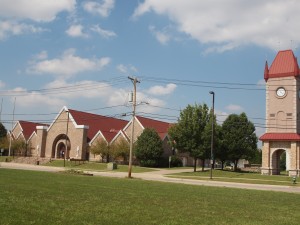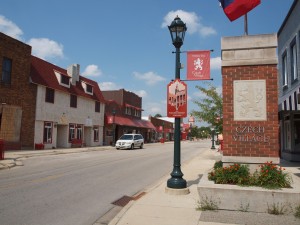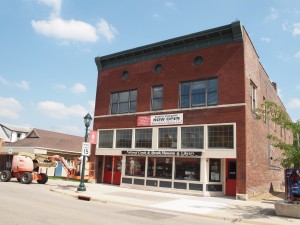The longer I work in the architecture, preservation and now sustainability fields, the more I realize that what good design means in one place may not be what good design means in another; what is a sustainable energy source in one place may not be possible in another; what is considered preservation in New York City and what is considered preservation in Cedar Rapids may be completely different things. What is important to my community, may not be important to yours. And the four long acknowledged “historic preservation” treatments as proclaimed by the National Park Service – preservation, rehabilitation, restoration and reconstruction – are in many places irrelevant, or are at best mixtures. Preservation, like everything else as I am realizing in my aging wisdom, exists in more of a gray world than I ever anticipated when I first studied preservation at Columbia in the mid-1980s.
Moving a Cultural Icon Across the Street
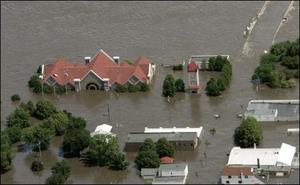
Eight feet of water poured through the National Czech & Slovak Museum & Library in June 2008. Photo courtesy NCSML website.
Moving a historic building isn’t even listed in the possible preservation treatments for historic buildings. It changes the historic context; it’s a treatment of last resort. But when the building is the most important building in your community and means more than where it happens to be located, then moving, as drastic as that is, may be all you can do, all you want to do. Every year I travel to Cedar Rapids, IA to visit relatives. Over the past couple of years the big story has been first the epic flooding of downtown Cedar Rapids in June, 2008 and then the follow up restoration of the buildings damaged from those shocking floods. One of the most heavily damaged sites was the National Czech & Slovak Museum & Library on the banks of the Cedar River. The Museum, built in 1993, is the heart of the largest Czech & Slovac community in the U.S., Czech Village. Indeed when the new museum opened in 1995, President Clinton, President Vaclav Havel of the Czech Republic and President Michal Kovac of the Slovak Republic presided over its dedication.

Preparing to “slide” the National Czech & Slovak Museum & Library across the street in June 2011. Photo courtesy NCSML website.
The museum had over $11M in damage when over eight feet of water flowed through the museum and the library. After evaluating the options of remaining where they were and having difficulty obtaining insurance because of the fear of another flood, demolishing the building and starting over somewhere else or moving the existing building, the museum chose to move its buildings and collections about 480 feet further from the river. The museum’s reasons for moving across the street included that it was less expensive to move the building than demolish and start over, they wanted to preserve the building for its historic value and they wanted to avoid creating unnecessary landfill waste. Since the building was still structurally sound, it was able to be moved and then placed on an elevated foundation – 11 feet higher than the previous site and three feet above the 2008 flood level. The building was moved over two days, June 8-9th, 2011. It was estimated that it weighed approximately 3 million pounds (or 1500 tons) and was constructed of wood frame and brick veneer. A video on their website takes viewers through the moving process. The project was overseen and designed by Durrant, an architectural firm headquartered in Dubuque, Iowa.** It’s really quite fascinating and I’m sorry we didn’t make it to Cedar Rapids to watch it. Since they went to this great effort, they expanded the building and added as many energy efficient and green measures as made sense including geothermal heating, solar thermal domestic hot water, increased wall and roof insulation, advanced lighting and daylighting controls. The project has submitted for LEED 2009 NC certification which is still in process, currently recording 45 points (Certified).
The building reopened July 14, 2012. We visited it about three weeks after it reopened. It was rather spooky seeing it on the other side of the street. The museum had temporarily located in a historic commercial building on Main Street in the Czech Village, the Kosek building, and this satellite remains open as a secondary gift shop and with exhibits about the flood. I love visiting the Czech Village. It’s across the river from the rest of downtown Cedar Rapids, and while it is somewhat isolated it also has significant charm and sense of place. Visiting the shops for Czech glass ware and pastries is always a treat when we visit.
Different Choices for Different Places
My initial thought was that this was a very odd thing to do. But since I had several years to consider it and observe its impact on the community, I warmed up to the idea. The building is only 20 years old and not particularly inspired from a design-sense. But it’s their museum and they are very proud of its meaning, of the visitors they have had there and of its importance to keeping their community alive. And now moving the museum has become an important part of their legacy as well. I like the fact that they consider it “historic” when it’s just 20 years old. It is in its own way a preservation win. And in this time of more and more preservation battles, we can take them wherever and however! And I like the fact that sustainability was a huge deciding factor as well.
Two Years & Counting
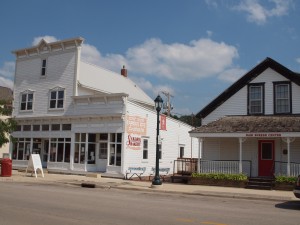
Typical commercial buildings in the Czech Village in Cedar Rapids. Here, both of these old buildings and the 20 year old museum are considered “historic.”
As a celebration of my firm’s two-year anniversary I will be posting each day this week about places I’ve visited in the past year. I’ve been thinking a lot about this move in Cedar Rapids since we were there last August and what it says about the importance of a concept of place to a community. There was an article in the NY Times yesterday about two historic black churches with profound historic significance which stand in the way of the new football stadium. Their congregations are debating whether to take the offer to move them elsewhere. And in the NY Times on Sunday, Robert A. M. Stern wrote a very heartfelt and informed op-ed about saving East Midtown from the city’s new zoning recommendations. I suggest you take a look at it if you are also beginning to question “all dense all the time.” I love this paragraph especially: In fact, the best path toward ensuring the future of East Midtown may well be that of preservation. Preservation, which too many in the real estate community reflexively oppose, has been a better stimulant for development than rezoning. SoHo and the Flatiron district were two of the most moribund parts of the city in the 1960s and ’70s; once they were designated as historic districts, the fortunes that poured in made them more vital than ever. Now if only MOMA would take up that mantra with the American Folk Art Museum.
**(Note: Sadly, Durrant Architects, the firm overseeing the move of the National Czech & Slovak Museum & Library, declared bankruptcy and ceased operations just prior to the completion of this project, unrelated to this project).
And if you’d like to “subscribe” or follow my blog, True Green Cities, please sign up through the “Subscribe” button at the bottom left of this page. You’ll receive a daily recap when new blogs are posted. Or Sign up for the Feed.

